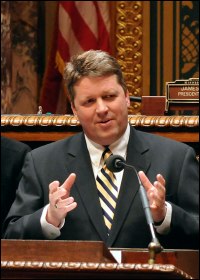Friendship House
What is the cost of not paying for mental health care? What is the cost of turning our backs on persons with mental disabilities? What is the cost of failing to provide community support for some of our most vulnerable citizens?
This past Wednesday I had the privilege to sit down with my friends at the Friendship House in Faribault. Among the two dozen or so persons present were consumers, case managers, the director, clinical psychologists, case managers, social workers, and a couple of legislators. The discussion touched on a variety of topics, but the concerns kept coming back to adequate state funding. As a state we must continue to find the resources to support organizations like Friendship House. Success is more likely if an individual has access to a combination of medication, supportive counseling and community support services, including education and vocational training. Working to keep those with mental disease out of our Psychiatric hospitals saves millions of dollars while providing dignity and a basic quality of life. It’s a small price to pay.
Friendship House continues to provide the supportive environment in which mental health consumers can socialize, and provide and receive support. With our help, educating and informing the public, employers, and policy makers, a higher value will be placed on recovery and the quality of life that a person with a severe mental illness can achieve.

 My brother Andy was born in 1977. In many ways, it was a sad day in our household. When he died nearly 20 years later, an entire community mourned.
My brother Andy was born in 1977. In many ways, it was a sad day in our household. When he died nearly 20 years later, an entire community mourned. Not surprisingly, several of our Minnesota schools are struggling with the issue of declining enrollment. One of the largest school districts in the state, the Anoka-Hennepin district, has lost 2000 students in the past five years and after a 5-1 vote by the school board Monday night; the district will be closing eight schools. While school finance can be a complicated subject, one aspect of it can be summarized rather simply – fewer students mean fewer dollars in the operating budgets of school districts. While the larger school districts make the choice to close schools or cut staff, smaller districts wrestle with smaller class sizes to the point that efficiency is lost and grade sharing and reorganization with other school districts become critical to long term survival. None of these changes is easy work.
Not surprisingly, several of our Minnesota schools are struggling with the issue of declining enrollment. One of the largest school districts in the state, the Anoka-Hennepin district, has lost 2000 students in the past five years and after a 5-1 vote by the school board Monday night; the district will be closing eight schools. While school finance can be a complicated subject, one aspect of it can be summarized rather simply – fewer students mean fewer dollars in the operating budgets of school districts. While the larger school districts make the choice to close schools or cut staff, smaller districts wrestle with smaller class sizes to the point that efficiency is lost and grade sharing and reorganization with other school districts become critical to long term survival. None of these changes is easy work. On Tuesday, October 6, the Commerce Committee of the Minnesota Senate met for a rare out of session hearing. The topic was ‘regulation of financial institutions in Minnesota.” The hearing was called in response to a few high profile bank failures that have occurred in several of our Minnesota communities this past summer. Like so many banks across the country, Minnesota small banks made several big bets on real estate and according to the Federal Reserve, Minnesota ranks fifth nationally in the number of banks with excessive levels of bad loans. Should we expect more banks to fail? Is there a problem?
On Tuesday, October 6, the Commerce Committee of the Minnesota Senate met for a rare out of session hearing. The topic was ‘regulation of financial institutions in Minnesota.” The hearing was called in response to a few high profile bank failures that have occurred in several of our Minnesota communities this past summer. Like so many banks across the country, Minnesota small banks made several big bets on real estate and according to the Federal Reserve, Minnesota ranks fifth nationally in the number of banks with excessive levels of bad loans. Should we expect more banks to fail? Is there a problem?
